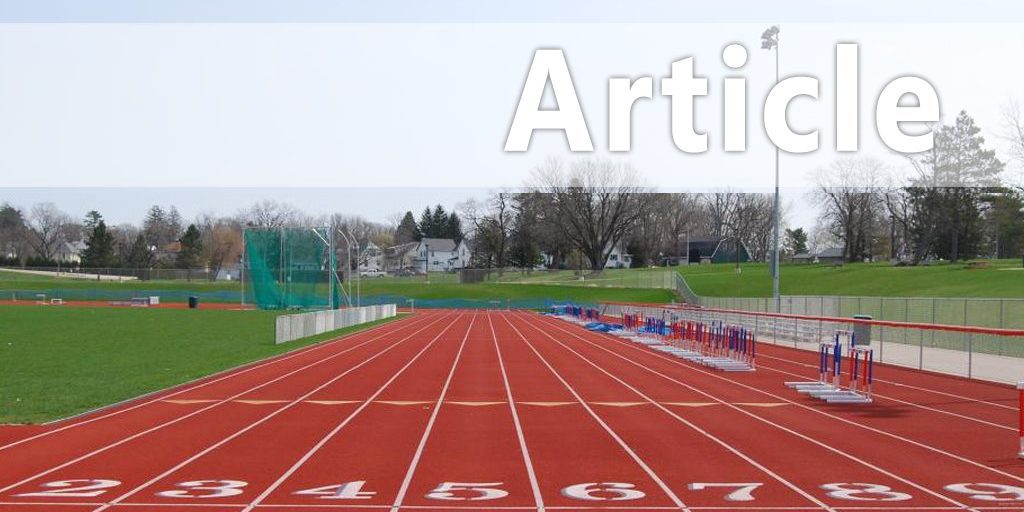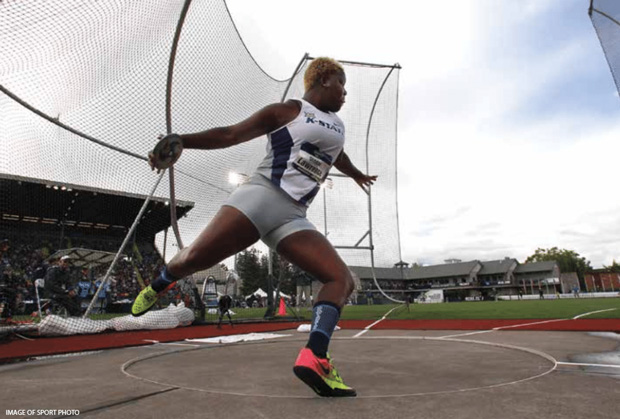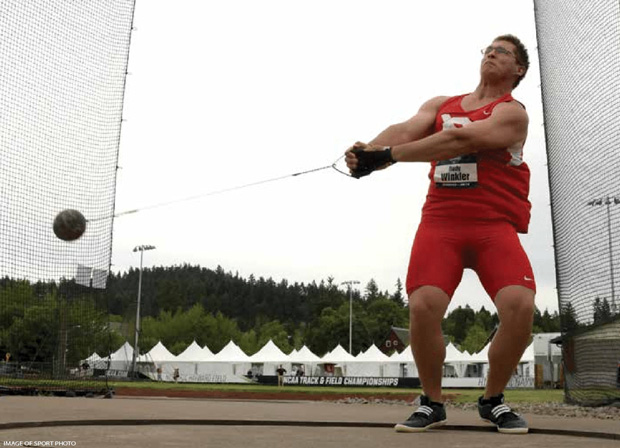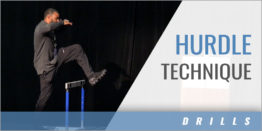| Throws - The Technical Commonalities |
| Originally Published in: Techniques Magazine
Provided by: USTFCCCA 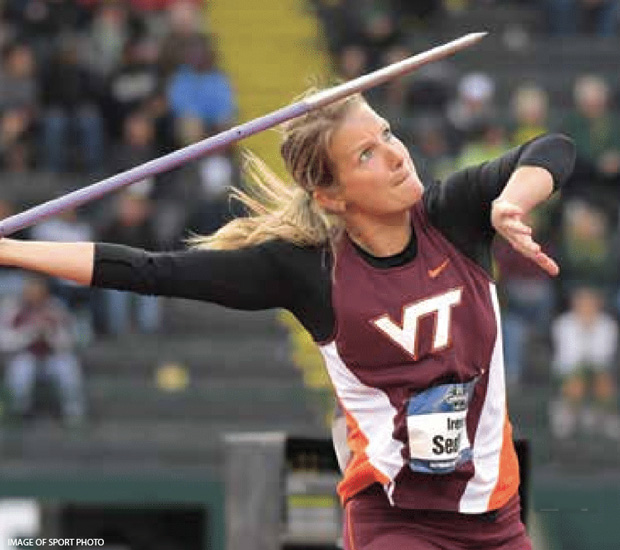 Preliminary movements of the throws include assuming the grip, assuming the starting position or stance, and any rhythmic or setup movements, such as winds. The approach refers to the locomotive movements that bring the athlete into position to deliver the implement. These movements include the glide in the shot put, the turns in the shot put, hammer and discus, and the run and crossovers in the javelin. The purpose of the approach is to develop momentum and velocity in the thrower/implement system. The delivery position refers to the position attained at the end of the approach, from which the implement is thrown. In most cases this is a position of double support, but in the javelin, the delivery begins in single support and finishes in double support. The delivery consists of the throwing movement as performed from the delivery position. The finish consists of the movements that occur after the implement's release. The finish consists of the follow-through and the reverse. Other important aspects to understand when discussing the throwing events are the strike, the follow through and the reverse. The strike consists of the upper body activity during delivery, particularly movements of the throwing arm(s). The follow-through consists of movements of the upper body, particularly the throwing arm(s), after the implement's release. While no additional force can be applied to the implement after release, the follow-through is important because its presence insures the absence of premature deceleration prior to release. The reverse consists of the readjustment of the stance that occurs immediately after release. The purpose of the reverse is to redirect unchecked momentum and prevent fouling.
MECHANICAL FACTORS AFFECTING THROWING PERFORMANCE Five factors dictate the performance on any given throw, and all technical teaching is geared toward affecting these parameters. • The Implement's Velocity at Release. The greater the velocity the implement displays at release, the longer the flight time and consequently the farther it will travel. • The Implement's Angle of Release. For each throwing event, there is an optimal angle of release that optimizes the flight path of the implement. This ideal angle of release is fairly consistent but may show slight variances based on environmental and anthropometric factors. • The Implement's Height at Release. Within the parameters of good technique, the higher the point of release of the implement, the better the performance. The height of release is primarily determined by anthropometric factors. • Aerodynamic Factors. The flight characteristics of an implement may be greatly altered by the shape of the implement, the spin or rotations of the implement, and the airflow around the implement caused by the implement's spin and travel. We classify these factors and their effects on performance as aerodynamics. The discus and javelin are aerodynamic implements. It is crucial for the thrower to ensure optimal angle of attack of the implement at release. An implement that displays proper attitude and pitch will achieve minimal drag and exhibit proper lift. • Spin and Oscillation. The spin of the javelin and discus provide stability to the implement during flight. Oscillations or vibrations compromise implement aerodynamics, and reduce performance. • Wind Direction. Wind direction can significantly aid or hinder discus and javelin performance. A head wind that assists a discus or a men's javelin, can prove detrimental to the women's javelin due to the unique characteristics of these implements. • Release Position with Respect to the Point of Measurement. Release position with respect to the point of measurement varies with each throwing event. It is not uncommon for a glide shot putter to project the throwing arm into the sector upon delivery, so that release of the implement actually occurs at a point that is beyond the point of measurement. Hammer and discus throwers release the implement from a position within the ring, at a point close to the point of measurement. Javelin throwers deliver well behind the point of measurement, allowing room for the follow through. COMMONALITIES OF THE APPROACH Each throwing event includes some type of approach. The approach can take different forms (a glide in the shot put, rotations in the discus, hammer, or shot put, or a run-up in the javelin). In each case, the approach serves three purposes. The approach provides the thrower and the implement with momentum and velocity, increasing the opportunity for good performances. The approach should place the thrower in the correct physical location from which to execute the delivery of the implement, so that proper technique can be used and distance preserved. The approach should place the body in the correct physical positions and motor environment to execute the mechanics of the delivery correctly. The approach should consist of a gradual, smooth acceleration. It is a common error for a thrower to accelerate too quickly in the approach, only to decelerate later. Demanding patience and cuing slow to fast rhythm is common coaching practice. Throwers should demonstrate proper posture in order to achieve the proper body positions for the delivery. The positions and alignment of the head, torso, and pelvis determine the quality of posture and should be constantly addressed.  The core of the body must be adequately stabilized to provide a solid base from which to apply force. This permits the body to apply force from a stable position, and withstand the impact associated with landing in the delivery position. The core of the body must be aligned correctly in order to position the limbs for efficient operation. We are most concerned with the alignment of the head with respect to the spine, and the alignment of the pelvis with respect to the spine. A neutral alignment of the head insures muscle relaxation, stability and balance. The location of the head also dictates mechanical characteristics of the many third class levers operational in the throwing musculature, so poor head alignment disrupts strike mechanics. A neutral or slightly upwardly tilted pelvis enables relaxation and proper leg function when throwing. While certain movements in the throws may require the pelvis to be slightly downwardly rotated, this rotation should not be excessive or permanent. Also, a downwardly rotated pelvis cannot turn, and the body normally substitutes shifting strategies, disrupting technique. This stabilized and aligned postural unit (head, spine, pelvis) must move in some predictable fashion. Erratic movements or radical changes in the path of movement of the body or implement make force application difficult. ACCELERATING THE IMPLEMENT According to the impulse equation, the longer we apply force to the implement, the greater the momentum changes in the implement will be. One strategy that throwers use to lengthen the amount of time they apply force to the implement is to lengthen the path the implement travels during the delivery. This is done in two ways: • Weight Transfer. During the delivery, bodyweight is transferred from the back foot to the front foot, to effectively increase the path of the implement. • Closed Throwing Positions. The delivery in throwing events begins with the body turned away from the direction of the throw. This enables the body to rotate through a greater angle as the implement is delivered, increasing the length of the path of the implement in a rotational sense. This alignment of the body, directed away from the throwing direction, is called a closed body position. Closed positions are used in all throwing events, but the nature of the implement may limit how closed the initial delivery position may be. The acceleration of the implement must be consistent and positive. It is common error for athletes to accelerate the implement too quickly initially, only to decelerate it later. This concept of consistent, progressive acceleration pertains to the approach and delivery phases. Many throwing events show implements that travel angular paths during the approach. In these cases, maximizing the curvilinear velocity of the implement is the primary concern. Maximizing curvilinear velocity requires positioning the implement as far as possible from the axis of rotation. Thus, in the discus and hammer, the greater the distance the implement is from athlete's axis of rotation, the greater implement velocity achieved. Typically during the approach, throwers use extended body positions to establish high angular momentum values. This enables the thrower at delivery to reduce the body's effective radius and exhibit high angular velocities. BLOCKING As the body arrives in the delivery position, the front leg should be in position to stop most of the horizontal movement of the body to set up transfer of momentum to the implement. This stopping of horizontal movement is called blocking. While deceleration is important, it should not be complete and abrupt, but characterized by some amortization. As the upper body turns and approaches the direction of the throw, the non-throwing arm should be pulled in toward the torso, decelerating the non-throwing side. This effectively moves the upper body's axis of rotation to the non-throwing side, accelerating the throwing side through an angular hinged moment. This block must be performed and completed before the shoulders reach a position where they are facing the direction of the throw. This permits this acceleration to occur in a useful direction. This block should decelerate rotational movement, but linear movement should continue. The turning of the hips during the delivery should be stopped when the hips axis reaches a point perpendicular to the throwing direction. This blocking transfers energy to the upper body and establishes a stable platform from which the strike may be executed.
SUMMATIONS OF FORCE Upper body activity in delivery and the strike should result from a summation of forces. The large muscle groups of the body's core initiate the movement. Joints subsequently contribute to force generation and application, progressing from the body's core outward. While each throw has a unique ideal firing order, proximal to distal firing must be preserved. This proximal to distal firing relationship is also observed in the rotational aspects of delivery, as the body's core turns first, while the upper body temporarily remains passive. During delivery, the body must turn smoothly in the direction of the throw. However, the upper and lower bodies do not turn from the same positions at the same time. In the delivery position, the shoulders are rotated farther from the direction of the throw than the hips. This relationship of the hips and shoulders is called separation, referring to the separation of their respective axes. Separation is present as the delivery position is achieved in all throws, but the specific positions of then hip axis, shoulder axis, and degrees of separation vary. In efficient throwing, during delivery, unique patterns of extension exist between the upper and lower bodies. The hip joint should extend in concert with the hip, the knee with the shoulder, the ankle with the wrist, etc. This has great implications for the rotation necessary in good throwing, since excessive and/or premature extension in the upper body will disrupt rotation and promote extension in the lower body, and vice versa. ELASTIC ENERGY GENERATION The sweep of the non-throwing arm, coupled with the block, serves to set up an elastic situation in the chest musculature that helps accelerate the implement. There is a slight amount of flexion in the legs that occurs in response to the impact associated with landing in the delivery position. This will set up an elastic situation as the legs extend, applying vertical force to the implement. The delivery phase of the throw should be initiated with a turning of the lower body, while the upper body remains passive. This creates a twisting of the core of the body called torque. This torque creates the potential for elastic energy generation as untwisting occurs, and serves as the mechanism by which rotational energy from the lower body is transferred to the upper body. In the throws, when we examine the path of the body's center of mass through the approach and delivery phases, we see vertical rises and falls. These provide opportunities for elastic loading via joint flexion and extension and potential energy development. An oscillating system is created requiring less energy input for high performance. When we examine the path of the implement through the approach and delivery phases, we also see vertical rises and falls. Again, these provide opportunities for elastic loading and potential energy development. These oscillations may also be found in other planes as well. LOWER BODY MECHANICS IN THE DELIVERY Generally, in throwing, a heel-ball alignment of the feet should be used in the delivery position. This means that the heel of the rear foot and the ball of the front foot should lie on a line corresponding to the direction of the throw. This alignment best permits blocking and turning as described below. During the delivery of most throwing activities, as the front foot grounds, the front foot should be aligned at approximately 40 degrees to the direction of the throw, so that the left toe points to the right for a right handed thrower. Because of the anatomical structure of the hip, this foot alignment permits the hips to stop turning when facing the throwing direction. This sets up better blocking and deceleration of the rotating hip axis. As delivery is initiated, the back foot should be directed approximately 90 degrees from the direction of the throw. This position varies slightly from event to event. As the rear foot grounds, some amortization should take place and the leg should amortize to some degree. This produces a passive, yielding contact. This flexion should remain in the rear leg throughout most of the delivery. Over-activeness or pushing off of this foot triggers extension reflexes and prevents the hip axis from turning in delivery. The feet should be spaced so that when weight is completely on the rear foot, the front leg is extended. This optimizes lengthening of the implement's path. During the delivery, bodyweight is transferred from the back foot to the front foot, to effectively lengthen the path of the implement. This weight transfer must be complete. The lower body should show a somewhat closed position as the body arrives in the delivery position. During the delivery, the lower body, particularly the hip axis, should turn smoothly and progressively to a position facing the direction of the throw. Anatomical structure of the hip will decelerate and block the hip axis properly if the stance is correct. Rotation and extension are conflicting kinetic chain functions, so premature extension of the rear leg serves to disrupt rotation. The hip axis cannot be pushed forward, it must be turned. Since weight is being transferred as this turning takes place, both legs must be involved. Early in the delivery phase, the rear leg is bearing most of the weight, and initiates the rotation. Later, the front leg is bearing most of the weight, and finishes the rotation. The turning and weight transfer movements during delivery should occur simultaneously, and at similar rates. Transferring then turning, or vice versa, produces an inherently inefficient arrangement. During delivery, extension of the legs produces a vertical force to the implement. Integration of vertical force generation from the legs and horizontal force application from the strike during delivery should be created in unison and with correct timing. UPPER BODY MECHANICS IN THE DELIVERY The grip is a critical part of the throw. The proper grip puts the wrist and hand in a position to contribute to force production. Because joints effectively communicate through networks of muscle and fascia, the positioning of the distal joint of a limb dictates much of the characteristics of the firing order of that limb. This means that the position of the hand and wrist dictate much of the firing characteristics of the entire throwing limb. Proper striking mechanics may be impossible to achieve if the grip is not correct. During the delivery, the upper body should turn smoothly and progressively from its closed position to a position facing the direction of the throw. This turning is initiated in response to the torque generated in the body's core. For this reason, the upper body must remain passive as delivery begins. In the delivery position, there are unique relationships between the position of certain body parts and the implement. As the delivery begins and turning takes place, these relationships should be preserved. It is a common error to initiate movement and turning in the upper body without moving the implement, destroying this positional relationship. It is also a common error to see the implement move without advancement or turning of the upper body, again destroying this relationship. A sweeping movement of the non-throwing arm prior to the strike can serve as a momentum development tool to enhance the strike. For this to occur, the arm must be in a somewhat extended position so that a significant moment is created. Also, momentum created is unique to a plane, so the movement must occur in the same plane as the strike. In single armed throwing events, as the upper body turns and approaches the direction of the throw, the non-throwing arm should be pulled in toward the torso, decelerating the rotation of the non-throwing side and producing an acceleration of the throwing side. Upper body activity in delivery and the strike should exhibit an efficient summation of forces. Weight transfer and turning of the torso initiate the movement, followed by contributions of the shoulder, then the elbow, then the wrist, hand, etc. While each throw has a unique ideal firing order, proximal to distal firing must be preserved. COMMONALITIES OF THE FINISH The reverse is a maneuver that enables the thrower to follow through, and maintain or regain balance after the throw is completed to prevent fouling. While it varies from event to event, it typically involves adjusting the stance and torso. Force application to the implement must be maximized, and to accomplish this, forces must be applied from a stable position. Reversing prematurely disrupts the latter stages of the strike and often results in the strike occurring from an airborne position. While some elite thrower do show flight in the final stages of delivery, in these cases this results from the application of huge forces in a correct summation, and is not at all the same as the premature reversal phenomenon. Having throwers do a significant amount of work with the feet fixed is common coaching practice. The throw should not be considered complete when the implement leaves the hand. Each throw has a position of locus of the throwing arm when its follow through motion stops. The strike should be considered a movement through the release to the locus position. While mechanically force is no longer being applied to the implement once it leaves the hand, failure to reach this position is indicative of premature deceleration. This article is taken from the USTFCCCA Track and Field Academy Throws Specialist Certification Course (SCC) text. Boo Schexnayder is primarily responsible for the content of the curriculum. Don Babbitt contributed to the material contained in this excerpt. |
